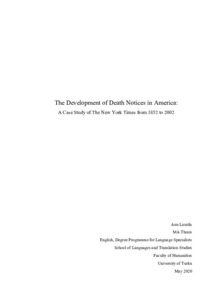The Development of Death Notices in America : A Case Study of The New York Times from 1852 to 2002
Laurila, Anu (2020-05-19)
The Development of Death Notices in America : A Case Study of The New York Times from 1852 to 2002
Laurila, Anu
(19.05.2020)
Julkaisu on tekijänoikeussäännösten alainen. Teosta voi lukea ja tulostaa henkilökohtaista käyttöä varten. Käyttö kaupallisiin tarkoituksiin on kielletty.
avoin
Julkaisun pysyvä osoite on:
https://urn.fi/URN:NBN:fi-fe2020062946235
https://urn.fi/URN:NBN:fi-fe2020062946235
Tiivistelmä
The present study focuses on the text type of death notices and their structural development in the American newspaper The New York Times between 1852 and 2002. Death notice is a term that is used when referring to short notices announcing the death of a person, usually published in newspapers by private persons. The analysis is based on a template model which was originally created for analyzing English death notices by Udo Fries in 1990 and which was further developed by Sarah Borde in 2015. The more recent and extended version of the template created by Borde was used in this study. The extended template model consist of thirteen different structural elements that are considered to be the main components of a death notice. The aims of this study are to observe how the different structural elements have developed in The New York Times death notices during the period of investigation and also to draw comparisons between the development of death notices in English newspapers and in The New York Times. In addition, the general applicability of the template model is tested as well, as it was originally created for English newspapers and is now applied to an American newspaper.
The data of this study consist of samples collected from the American newspaper The New York Times. In total, there are 216 sample death notices that were collected in 20-year intervals between 1852 and 2002. There were nine sample years and 24 sample death notices were collected per year. The different elements in the death notices were analyzed to observe the frequencies of their occurrences and their linguistic realizations during different sample years. These results were then compared with Borde’s results on English death notices. However, the emphasis of this study was on the development of the American death notices, as they have not been studied diachronically before.
The results of the analysis indicate that the different structural elements in The New York Times have developed in various ways over the period of investigation and that there are some similarities and some differences between the development of the different elements in English and in American death notices. Some of the differences could be explained with different cultural customs but other differences appeared to be more arbitrary. In general, the template model could be applied well to the death notices in The New York Times. However, as this was only a pilot study that focused on only one American newspaper, future research should be conducted on other American newspapers as well to see if there are regional and/or newspaper-specific differences in the development of the different structural elements.
The data of this study consist of samples collected from the American newspaper The New York Times. In total, there are 216 sample death notices that were collected in 20-year intervals between 1852 and 2002. There were nine sample years and 24 sample death notices were collected per year. The different elements in the death notices were analyzed to observe the frequencies of their occurrences and their linguistic realizations during different sample years. These results were then compared with Borde’s results on English death notices. However, the emphasis of this study was on the development of the American death notices, as they have not been studied diachronically before.
The results of the analysis indicate that the different structural elements in The New York Times have developed in various ways over the period of investigation and that there are some similarities and some differences between the development of the different elements in English and in American death notices. Some of the differences could be explained with different cultural customs but other differences appeared to be more arbitrary. In general, the template model could be applied well to the death notices in The New York Times. However, as this was only a pilot study that focused on only one American newspaper, future research should be conducted on other American newspapers as well to see if there are regional and/or newspaper-specific differences in the development of the different structural elements.
